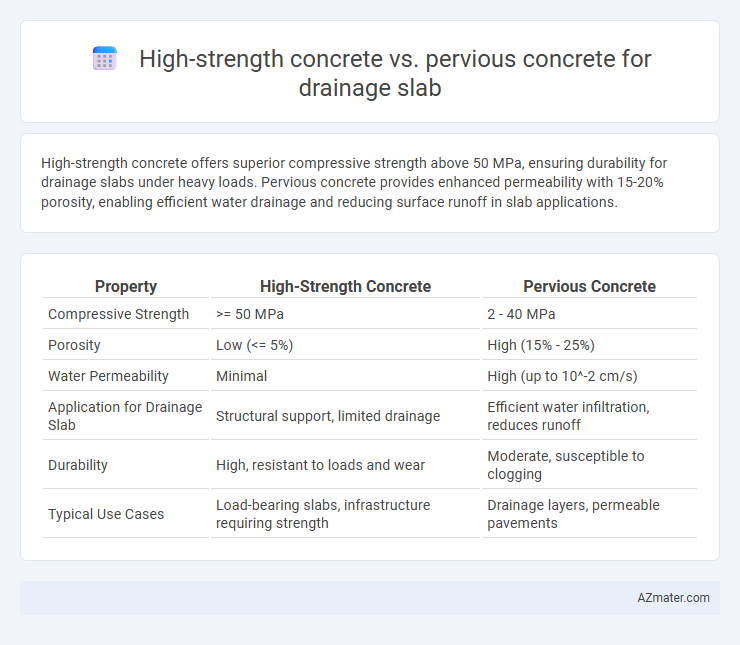High-strength concrete offers superior compressive strength above 50 MPa, ensuring durability for drainage slabs under heavy loads. Pervious concrete provides enhanced permeability with 15-20% porosity, enabling efficient water drainage and reducing surface runoff in slab applications.
Table of Comparison
| Property | High-Strength Concrete | Pervious Concrete |
|---|---|---|
| Compressive Strength | >= 50 MPa | 2 - 40 MPa |
| Porosity | Low (<= 5%) | High (15% - 25%) |
| Water Permeability | Minimal | High (up to 10^-2 cm/s) |
| Application for Drainage Slab | Structural support, limited drainage | Efficient water infiltration, reduces runoff |
| Durability | High, resistant to loads and wear | Moderate, susceptible to clogging |
| Typical Use Cases | Load-bearing slabs, infrastructure requiring strength | Drainage layers, permeable pavements |
Introduction to Concrete Types for Drainage Slabs
High-strength concrete offers superior compressive strength and durability, making it ideal for load-bearing drainage slabs that require long-term structural integrity. Pervious concrete features a porous structure allowing water to pass through, effectively managing stormwater runoff and reducing surface water accumulation. Selecting the appropriate concrete type for drainage slabs depends on balancing performance needs such as strength, permeability, and environmental benefits.
Defining High-Strength Concrete
High-strength concrete is defined by its compressive strength exceeding 6,000 psi (41 MPa), achieved through optimized mix designs with low water-cement ratios and supplementary cementitious materials like silica fume. This type of concrete provides superior durability and load-bearing capacity, making it suitable for structural applications that require high performance. In contrast, pervious concrete prioritizes permeability over strength, facilitating effective drainage in slabs but with significantly lower compressive strength, typically between 1,500 and 4,000 psi (10 to 28 MPa).
Understanding Pervious Concrete
Pervious concrete is specifically designed to allow water to pass through its porous structure, making it ideal for drainage slabs by reducing surface runoff and promoting groundwater recharge. Unlike high-strength concrete, which prioritizes compressive strength and durability, pervious concrete balances sufficient structural integrity with high permeability, typically featuring void content between 15-25%. The open-celled matrix of pervious concrete enhances stormwater management and mitigates urban flooding, positioning it as an environmentally sustainable solution for drainage applications.
Key Material Properties Comparison
High-strength concrete offers superior compressive strength often exceeding 6000 psi, making it ideal for load-bearing drainage slabs requiring durability and minimal deformation under heavy traffic. Pervious concrete, characterized by its high porosity of 15-25%, allows effective water infiltration, reducing surface runoff and promoting groundwater recharge but typically has lower compressive strength around 2000-4000 psi. The choice hinges on balancing mechanical strength requirements against permeability, with high-strength concrete excelling in structural integrity and pervious concrete optimizing drainage performance.
Drainage Performance Analysis
High-strength concrete offers superior compressive strength and durability but has limited permeability, resulting in slower water infiltration rates compared to pervious concrete. Pervious concrete's interconnected void structure enhances drainage performance by allowing rapid water passage, reducing surface runoff and promoting groundwater recharge. Drainage slab applications benefit from pervious concrete's ability to maintain efficient water flow, while high-strength concrete is preferred where structural load bearing and reduced permeability are critical.
Structural Strength Considerations
High-strength concrete offers superior compressive strength, typically exceeding 70 MPa, making it ideal for load-bearing drainage slabs requiring durability and resistance to heavy traffic. In contrast, pervious concrete, with its high porosity and lower compressive strength (generally between 20-35 MPa), excels in water permeability but compromises structural robustness. Choosing high-strength concrete ensures enhanced durability and load capacity, while pervious concrete prioritizes effective stormwater management but may require reinforcement for structural stability.
Durability and Lifespan Factors
High-strength concrete offers superior compressive strength and resistance to wear, making it highly durable for drainage slabs subjected to heavy loads and extreme weather conditions. Pervious concrete enhances water permeability, facilitating effective drainage but typically exhibits lower compressive strength and increased susceptibility to clogging and freeze-thaw cycles, which can reduce its lifespan. Selecting the appropriate concrete type depends on balancing structural durability with drainage efficiency to ensure long-term performance.
Environmental Impact and Sustainability
High-strength concrete offers durability and load-bearing capacity but has a higher carbon footprint due to its cement content, impacting environmental sustainability negatively. Pervious concrete enhances stormwater management by allowing water infiltration, reducing runoff and promoting groundwater recharge, thus supporting sustainable urban drainage systems. Choosing pervious concrete for drainage slabs aligns better with eco-friendly construction practices by minimizing pollution and mitigating urban heat island effects.
Cost and Maintenance Requirements
High-strength concrete offers superior durability and load-bearing capacity for drainage slabs but comes with higher initial material costs and more complex maintenance due to its dense structure. Pervious concrete provides excellent water permeability, reducing surface runoff and easing drainage, with generally lower installation costs and simplified maintenance focused on preventing clogging. Selecting between the two depends on project budget constraints and long-term maintenance capabilities, where pervious concrete reduces drainage infrastructure demands but may require periodic vacuuming to maintain porosity.
Best Applications and Recommendations
High-strength concrete offers superior compressive strength and durability, making it ideal for drainage slabs subjected to heavy loads and traffic, such as industrial floors and highway shoulders. Pervious concrete provides excellent permeability for effective stormwater management and is best suited for low-traffic areas like parking lots and pedestrian walkways where rapid drainage is essential. For optimal performance, use high-strength concrete in structural drainage slabs requiring load-bearing capacity, and select pervious concrete when infiltration and environmental sustainability are priorities.

Infographic: High-strength concrete vs Pervious concrete for Drainage slab
 azmater.com
azmater.com